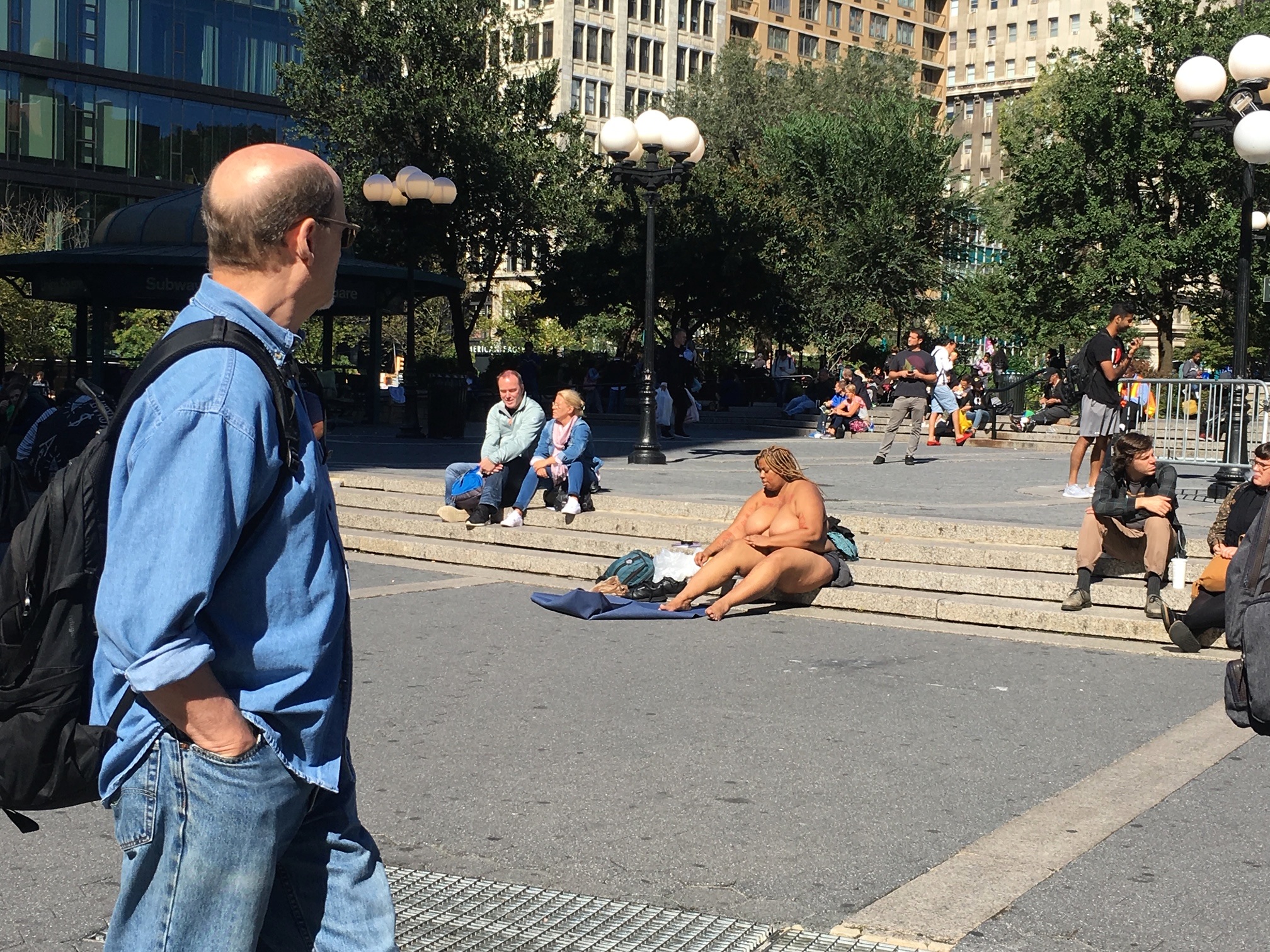“Is my presence a stain that can never be removed…” by Nicole Goodwin (Artist, AiOP BODY 2018)

Nicole Goodwin, “Ain’t I a Woman (?/!)”, photo Katya Grokhovsky
Bodies. In this age we are privy to works of art that deal with the body in provocative ways. Ways outside the dictated norms and standards set by the classical viewing of the body and the acceptance of Western standards. This can be seen as a threat to those who enforce those standards and censorship is a dangerous way of prohibiting ideas that can change the course of an audience reactions to how our society operates.
When chosen to perform “Ain’t I a Woman (?/!)” at the 2018 iteration of Art in Odd Places (AiOP) I was excited but also hesitant. The idea of performing such and intimate work always sends me in a spiral of exuberance and self-doubt; these two forces pull at my insides up until when I literally am performing, each emotion gripping into my mind, body and spirit-holding on up until the very last second. “Ain’t I a Woman (?/!)” is my way of tackling issues concerning the Black body presence and existence in the Western society, but I pushed it further for AiOP including political responses to the Kavanagh verdict that had just come out a week before. Responding to rape is a personal recourse due to my past in the Army and my suffering from Military Sexual Trauma. This coincides with the previous appearances of “Ain’t I a Woman (?/!),” but also evolves the work to include other issues revolving around large Black bodies.
What I found disappointing is that my piece had become dependent upon social media and the betrayal that came with Facebook’s and Instagram’s community standards and policies. When it comes to large bodies there seems to be a standard of censorship that doesn’t apply to bodies that are more mainstream and accepted. The procedures conjoin with the public beratement I felt every time the cops and ambulance were called to collect me, for being “irate” and for conduct that was “inappropriate”, while in full knowledge that I was not breaking any laws. Toplessness is permissible in New York City, and yet the social decorum only allows for “certain bodies” to display this. Bodies that are deemed worthy to be on display as a way of further policing “undesirable” bodies through shame.
It seems that my body is caught in a vicious cycle to receive such treatment, while social media pages on Facebook allow for the most violent of scenes to go unchecked and unregulated. Or better said by Ayana Evans, “Facebook – where’s your violence algorithm?”. Which leaves me to wonder who or what these programs and practices are designed to protect and why. This censorship in real life and in the virtual world is a slap in the face considering how Black bodies are not allowed their own space and respect in public. The larger the Black body, the bigger the perceived threat, and swifter and harsher the retaliation against it. Case in point, I was banned from using Facebook for three days, unable to promote my show due to one post that showed my breasts. Yet fetish porn goes shared and uncensored throughout its’ pages and those that do share such things go unpunished—this is not to say that fetish doesn’t belong in the realms of social media, but moreover to say that the fetishism of Black bodies under the white gaze is a dangerous form of erasure. This leaves me to believe that those behind the algorithm are judging more than social conduct, they oversee judging social practices that interrogates and questions authority, by way of art and quite possibly – protest.
People often ask why I don’t just cover up my breasts before I display the pieces, or why don’t I notify the police before I begin my practice in public. And to them I say this: I want my piece to be as authentic as possible. With performance art there is some risk, but in this running of that risk you find the greatest of truths. I do not feel that my partial nudity in my work should be regulated as problematic and conducting myself in a way that censors or augments the reality within the work gives way into thinking as such.
In the durational video I ask, “Is my presence a stain that cannot be removed?” who I am addressing isn’t just those who bore witness to the durational piece, I am asking that of society at large. A society that is dependent on standards set by those that govern the law—as well as the community standards that the internet dictates and enforces others to follow. When those forces combine to create and atmosphere in our daily rituals that exclude the rights of those challenging and questioning the logic behind censorship, our very existence becomes binary, and banal.
I often ask myself, is this practice worth undergoing the ridicule that society enforces both in and outside of cyberspace? The concept of policing large Black bodies under the guise of “safety” through police and ambulance workers mirrors the application of enforcing dubious community standards through social media, in that although no laws were being broken, my presence and existence in “white spaces” is an unspoken liability. Yet this concept in itself is indeed why “Ain’t I a Woman (?/!)” is a necessity. Exposing such practices challenges people, and places to move forward in the conceptualism of the Black form. I pose topless to push these boundaries to the limits. By obeying the law and yet exposing my body in the extreme, I ride the fence that pushes our society’s prejudice against anything other than the mainstream physique.

